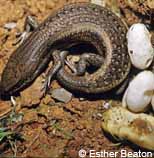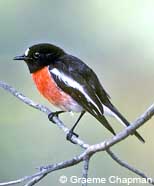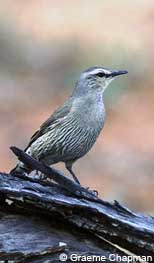About Woodlands
Meet the Animals
Conservation Tips
Puzzles
Further Info
Fallen timber is habitat for many animals and provides them with a place to rest, hibernate, lay eggs, rear young and find food. Many animals also use logs as ‘runways’ through the bush and fallen timber provides birds (such as the Scarlet Robin) with a place to perch to advertise their territory and watch for predators. Fallen timber is also beneficial for the soil, locally trapping sediment, nutrients and water and, as the log rots, acting as a ‘slow-release fertiliser’.


Southern Rainbow Skink Carlia tetradactyla
The Southern Rainbow Skink is found in south-east Queensland, NSW and northern Victoria. It is uncommon in Victoria and the southern slopes of NSW. It is found in dry forests, woodlands and grassy ecosystems. Males display bright aqua and orange colours along their flanks during mating season.
Key habitat needs: Fallen timber, rocks, woody debris, tussock grasses and leaf litter are used by the Southern Rainbow Skink for shelter and foraging for insects and termites.
Did you know? Even though the Southern Rainbow has the ability to shed its tail to escape predators, a short tail means a loss of social status and male lizards with short tails are much less likely to reproduce.

Yellow-footed Antechinus Antechinus flavipes
The Yellow-Footed Antechinus is widespread and common in some parts of its range. It is found in south-eastern South Australia through to northern Queensland and in south-west Western Australia. It inhabits a range of landscapes including rainforest, swamps, dry forests, woodlands and mulga.
Key habitat needs: The antechinus makes nests in hollow trees and sometimes in fallen hollow logs. It forages amongst fallen timber and leaf litter and uses these habitat features as "runways" through the landscape.It also feeds on nectar from understory plants.
Did you know? As with all species of antechinus, the male yellow-footed antechinus dies late in winter each year after a two-week 12 hour-a-day mating frenzy. Females usually also only live for one generation, although some can live for two.

Scarlet Robin Petroica multicolor
The Scarlet Robin is widespread throughout south-eastern Australia in Tasmania, South Australia, Victoria, eastern NSW and south-eastern Queensland. It is also found in south-west Western Australia. It inhabits open forests, woodlands and parks. It is an altitudinal migrant, meaning it moves to lower elevations in winter. The Scarlet Robin is a declining species in South Australia and West Australia. This is mostly because of land clearing.
Key habitat needs: The Scarlet Robin likes scrubby understorey vegetation with a sparse layer of saplings and shrubs in which they can forage and build nests. They generally sit on a perch, watching for prey and then dart to the ground to catch it.
Did you know? Australian Robins are not even closely related to those in North America and Europe. When Europeans settlers arrived they simply transferred names from the northern hemisphere to Australian birds with similar characteristics.

Brown Treecreeper Climacteris picumnus
The Brown Treecreeper is found throughout Queensland, NSW, Victoria and eastern South Australia. It lives in dry open-forest and woodland areas. It is a gregarious bird which forages by hopping in a spiral pattern up a tree or among fallen timber.
Key habitat needs: Large patches of native remnant vegetation is important for the Brown Treecreeper. It forages amongst fallen logs and trees and uses hollows for nesting. It is a declining species in the parts of its range which have been subject to clearing, particularly where remaining patches of suitable habitat are isolated and fallen timber has been removed.
Did you know? Brown Treecreepers can be aggressive when territory is up for grabs. Territories are often inhabited by a male and several helpers who feed the breeding female. The males and their helpers may get into scraps with their counterparts from neighbouring territories.

Lace Monitor Varanus varius
The Lace Monitor occurs throughout much of Victoria, NSW and eastern Queensland and in a small parts of south-eastern South Australia. In Victoria and on the NSW South-West Slopes, it is rare. The animal is declining in may areas due to land clearing, an increase of feral predators and loss of suitable large, old habitat trees. Illegal collecting is also a threat.
Key habitat needs: The Lace Monitor inhabits large woodland areas (more than 50 ha in size). It requires plenty of fallen hollow logs, trees with hollows and termite mounds for depositing its eggs. One way of finding out if Lace Monitors inhabit an area is to inspect the trunks of smooth-barked gum trees. If a Lace Monitor regularly uses the tree, there will be marks left from its sharp claws.
Did you know? Lace Monitors dig into termite mounds, especially those in trees, to lay their eggs. They then exit the mound and reseal it. The mother knows when the eggs are due to hatch and at that time she returns to the mound and digs it open to free the baby monitors.

